
Миф об экономическом росте и почему растет социализм
Автор Лэнс Робертс через RealInvestmentAdvice.com,
Меня недавно спросили о кажущейся сильной «Экономический рост» ФРС готовится начать снижение ставок.
«Если экономический рост настолько силен, как отмечается в недавнем докладе о ВВП, то почему Федеральная резервная система снижает ставки? "
Это хороший вопрос, который заставил меня задуматься о тенденции экономического роста, долга и о том, где мы, вероятно, будем.
После окончания финансового кризиса экономисты, аналитики и Федеральная резервная система продолжали прогнозировать возвращение к более высоким уровням экономического роста. Остается надежда, что триллионы долларов, потраченные во время экономического спада, вызванного пандемией, превратятся в устойчивый органический экономический рост. Однако проблема заключается в том, что, хотя искусственный стимул создал всплеск инфляционного давления, он мало что сделал, чтобы вызвать органическую экономическую активность, которая переживет расходы, связанные с стимулированием.
Продвижение вперед роста
Рост в течение последнего десятилетия остается основным инструментом Федеральной резервной системы для стабилизации финансовых рынков, в то время как темпы экономического роста и инфляция остаются слабыми. От повторных раундов монетарных и фискальных интервенций рынки активов выросли, увеличив благосостояние инвесторов и доверие, что, как заявил в 2010 году Бен Бернанке, будет поддерживать экономический рост. В смысле:
"Этот подход облегчил финансовые условия в прошлом и до сих пор выглядит эффективным. Цены на акции выросли, а долгосрочные процентные ставки упали, когда инвесторы начали предвидеть самые последние действия. Легкие финансовые условия будут способствовать экономическому росту. Например, более низкие ставки по ипотечным кредитам сделают жилье более доступным и позволят большему количеству домовладельцев рефинансировать. Снижение ставок по корпоративным облигациям будет стимулировать инвестиции. Более высокие цены на акции повысят благосостояние потребителей и помогут повысить доверие, что также может стимулировать расходы. " Бен Бернанке
Это, безусловно, имело место, поскольку вмешательство Федеральной резервной системы поддерживало стабильность финансовых рынков и экономики каждый раз, когда экономика спотыкалась. Однако имеются достаточные доказательства того, что «Монетарная политика» Это приводит к другим проблемам, особенно к всплеску неравенства в богатстве.без соответствующего роста экономики.
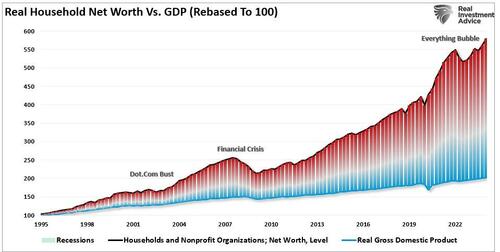
Неотъемлемая проблема продвижения потребления заключается в том, что, хотя оно может решить краткосрочные экономические проблемы, в будущем оно оставляет все большую «пустоту», которую необходимо заполнить. Проблема, неудивительно, заключается в том, что «Монетарная политика» Это не экспансионизм. Как показано, с 2008 года общий совокупный рост экономики составил всего $6,1 трлн. Другими словами, каждый доллар экономического роста с 2008 года требовал почти 6,7 доллара монетарного стимулирования. Это звучит хорошо, пока вы не поймете, что это произошло исключительно из-за долговой эмиссии.
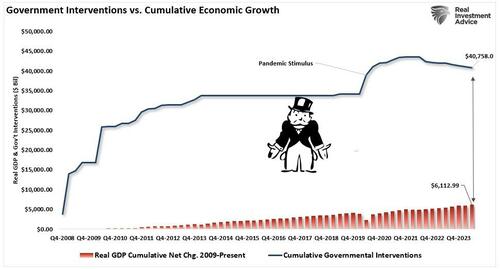
Конечно, очевидная проблема заключается в том, что поддержание такой денежно-кредитной политики, основанной на долге, нереалистично. В этом и заключается вопрос о «Сильный экономический рост» повествование.
Отсутствие экономического роста
В то время как экономисты, политики и аналитики указывают на текущие данные и в первую очередь совпадающие показатели для создания "бычий спин«Для инвестиционной общественности ухудшение экономического процветания является гораздо более важной долгосрочной проблемой. Вопрос, который мы должны задать: "Почему это происходит? "
С 1950-1980 годов номинальный ВВП рос в годовом исчислении на 7,55%, достигнув при этом общего отношения долга кредитного рынка к ВВП менее 150%. Критический фактор заключается в том, что экономический рост в течение этого периода имел тенденцию к росту, от примерно 5% до пика почти 15%. Для этого было несколько причин. FБолее низкие уровни долга позволили личным сбережениям оставаться устойчивыми, что способствовало производительным инвестициям в экономику. Во-вторых, экономика была ориентирована прежде всего на производство и обрабатывающую промышленность, что оказало на экономику большое мультипликативное воздействие. Этот подвиг роста также произошел перед лицом неуклонно растущих процентных ставок, которые достигли пика с экономической экспансией в 1980 году.
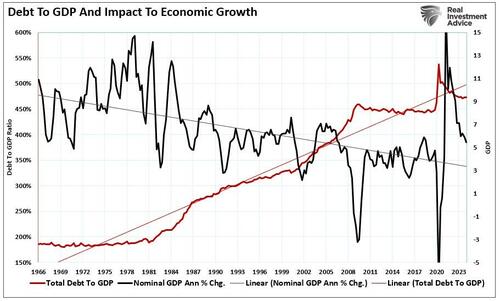
Однако, начиная с 1980 года, переход от экономики, основанной на производстве, к экономике услуг и финансов с низким экономическим мультипликатором частично отвечает за эту трансформацию. Снижение экономического производства еще более усугублялось увеличением производительности за счет технологических достижений и производственного аутсорсинга, которые преследовали экономику с постоянно снижающейся заработной платой. В отличие от стабильно растущей экономической среды до 1980 года, экономика после 1980 года пережила устойчивый спад. Поэтому утверждение о том, что с 1980 года в экономике наблюдался средний рост на Х%, вводит в заблуждение. Тенденция роста гораздо более важна и показательна, чем средние темпы роста с течением времени.
Драги о потребителях
Это снижение экономического роста за последние 40 лет заставило среднего американца бороться за поддержание своего уровня жизни. Поскольку их заработная плата снизилась, они обратились к кредитам, чтобы заполнить пробел и сохранить свой текущий уровень жизни. Этот спрос на кредиты стал новой питательной средой для экономики, основанной на финансировании. Более доступные условия кредитования, более низкие процентные ставки, более простые стандарты кредитования и меньшее регулирование способствовали продолжающемуся буму потребления. Пока экономика росла вместе с «Свободные деньги» Посылаемые домохозяйствам, обращение вспять этой выгоды в конечном итоге вернет экономику, рост заработной платы и потребление к продолжающемуся долгосрочному нисходящему тренду.
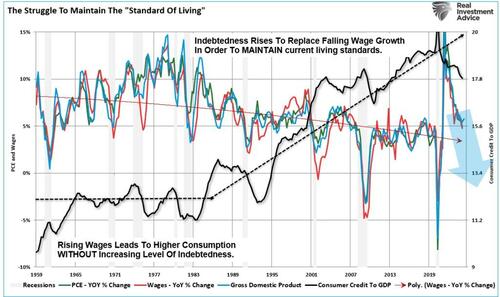
Вот почему экономическое процветание последних 40 лет было фантазией. В то время как Америка, по крайней мере на первый взгляд, завидовала миру своим очевидным успехом и процветанием, рак, лежащий в основе расширения долга и снижения заработной платы, разъедал ее сердцевину. Единственный способ сохранить "Уровень жизни" Мы должны были использовать постоянно растущий уровень долга. Финансовые институты, которые сейчас регулируются, были слишком счастливы, чтобы гарантировать, что «кредит» Это был финансовый крах массового масштаба.
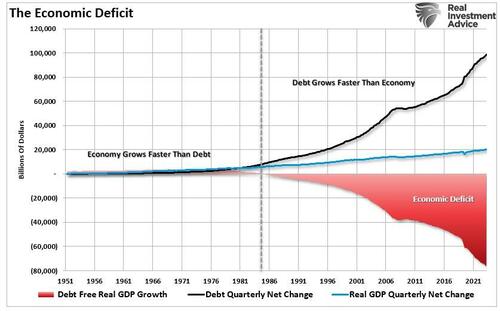
Почему растет «социализм»
Массовое потворство долгам, как называют австрийцев а «кредитный бум», Вероятно, он пришел к неизбежному выводу. Неустойчивый бум кредитования, который привел к искусственному стимулированию заимствований, продолжает искать постоянно сокращающиеся инвестиционные возможности. В конечном счете, эти уменьшенные инвестиционные возможности неоднократно приводили к широко распространенным недобросовестным инвестициям. Неудивительно, что мы увидели, как он разыгрался. «Реальное время» Во всем, начиная с субстандартных ипотечных кредитов и заканчивая производными инструментами в 2008 году, которые только доили систему каждого потенциального пенни, независимо от очевидного базового риска. Мы видим этоОпять же в «Погоня за доходностью» Во всем, от мусорных облигаций до акций. Неудивительно, что результат не будет отличаться.
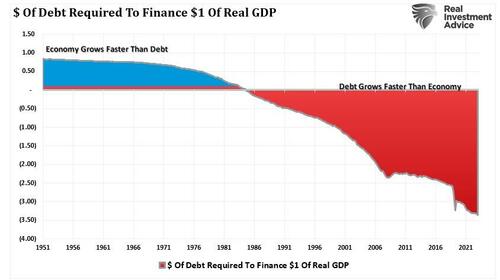
Борьба американского среднего класса продолжает расти, и разрыв между богатыми и бедными становится очевидным. Вот почему крики о социализме становятся такими громкими. Требования к бесплатному здравоохранению, образованию и жилью являются «Песня Сирены» Чтобы политики приняли больше законов для расширения государственного контроля и перераспределения богатства от среднего класса и бедных к правящей элите.
Цикл Тайтлера
Но это не должно быть сюрпризом. Это цикл всех экономических цивилизаций с течением времени. «Забудьте нашу историю» и обречены на повторение. Шотландский экономист Александр Тайтлер, который в 1787 году прокомментировал тогдашнюю новую американскую республику следующим образом:
«Демократия всегда носит временный характер; она просто не может существовать в качестве постоянной формы правления. Демократия будет существовать до тех пор, пока избиратели не обнаружат, что они могут голосовать за щедрые подарки из государственной казны. С этого момента большинство всегда голосует за кандидатов, которые обещают наибольшую выгоду от государственной казны, в результате чего каждая демократия, наконец, рухнет из-за свободной фискальной политики, за которой всегда следует диктатура.
Средний возраст величайших цивилизаций мира составляет около 200 лет. Эти страны всегда продвигались через эту последовательность:"
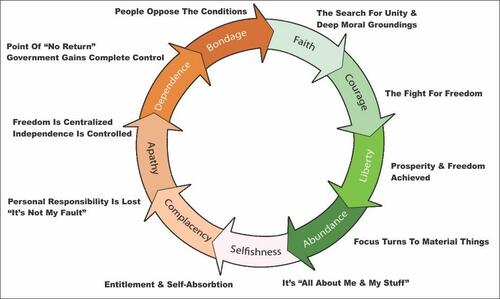
Идея социализма прекрасно звучит в теории.. Задолженность за непроизводительные инвестиции, такие как социальное обеспечениеБесплатный колледжне дает обещанной экономической выгоды. Вместо этого инфляция, вызванная притоком «Свободные деньги» тормозит экономический рост. Кроме того, инфляция «Налоги» 50% самых низкооплачиваемых работников.
Обещание чего-то ни за что никогда не потеряет своего блеска. Однако ни одно общество никогда не процветало через социализм или коммунизм. Бедные оставались бедными, средний класс становился бедным, а богатые процветали. Поэтому мы должны рассматривать социализм как политическую пропаганду, а не как экономическую или государственную политику. И, как и всякая пропаганда, мы должны бороться с ней призывами к реальности. Социализм, где дефициты не имеют значения, нереально.
Заключение
Вполне вероятно, что «Что-то пошло не так» Для Федеральной резервной системы была достигнута эффективность продвижения будущего потребления посредством денежных интервенций. Несмотря на постоянные надежды «Высокие темпы роста» В будущем такого, скорее всего, не произойдет, пока долговой навес в конечном итоге не будет снят.
Означает ли это, что все обречено? Конечно Нет. Тем не менее, мы, вероятно, останемся ограниченными в текущей ситуации. «Шпора и шлепок» Цикл роста мы наблюдаем с 2009 года. Это будет отмечено продолжающейся волатильностью доходности фондового рынка и стагфляционной средой, поскольку заработная плата остается подавленной, а стоимость жизни растет. В конечном счете, очистка избыточных уровней долга позволит нормам личных сбережений вернуться к уровням, способствующим производительным инвестициям, производству и потреблению.
Конечная игра четырех десятилетий излишков на нас, и мы не можем отрицать вес долговых дисбалансов, которые в настоящее время в игре.
Но больше социализма не является ответом.
Тайлер Дерден
Фри, 08/16/2024 - 08:25















